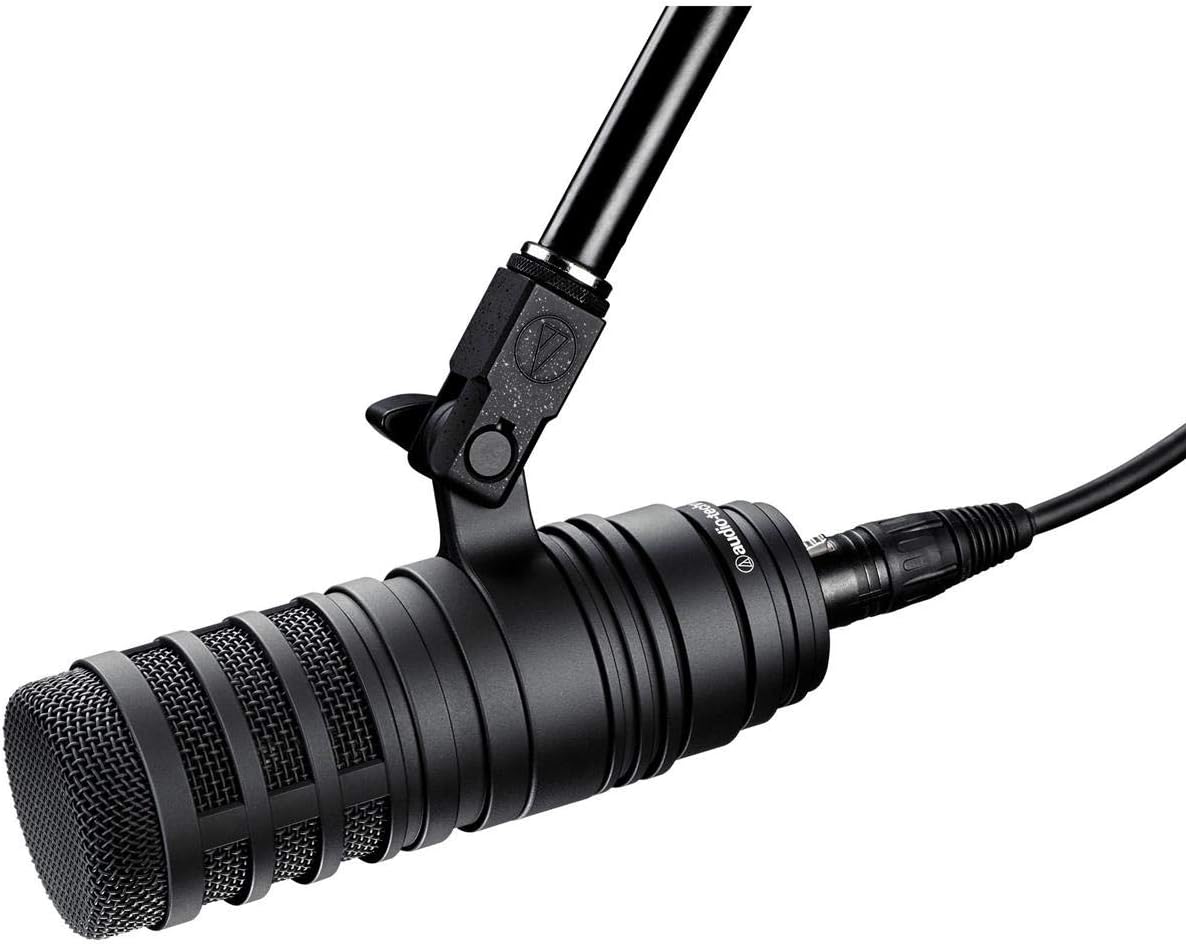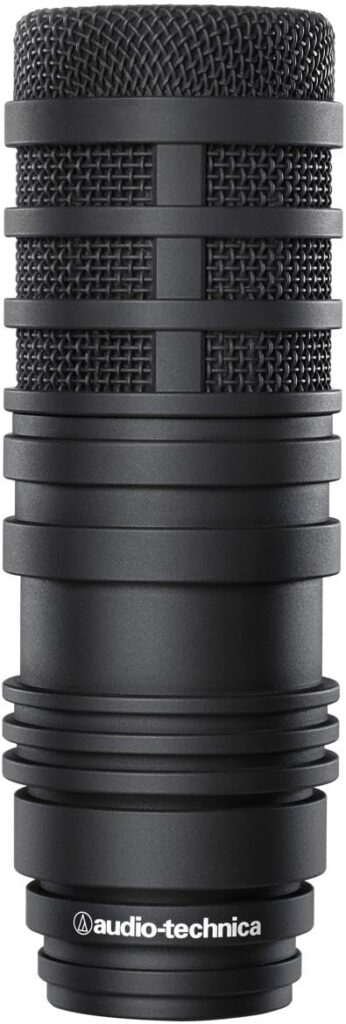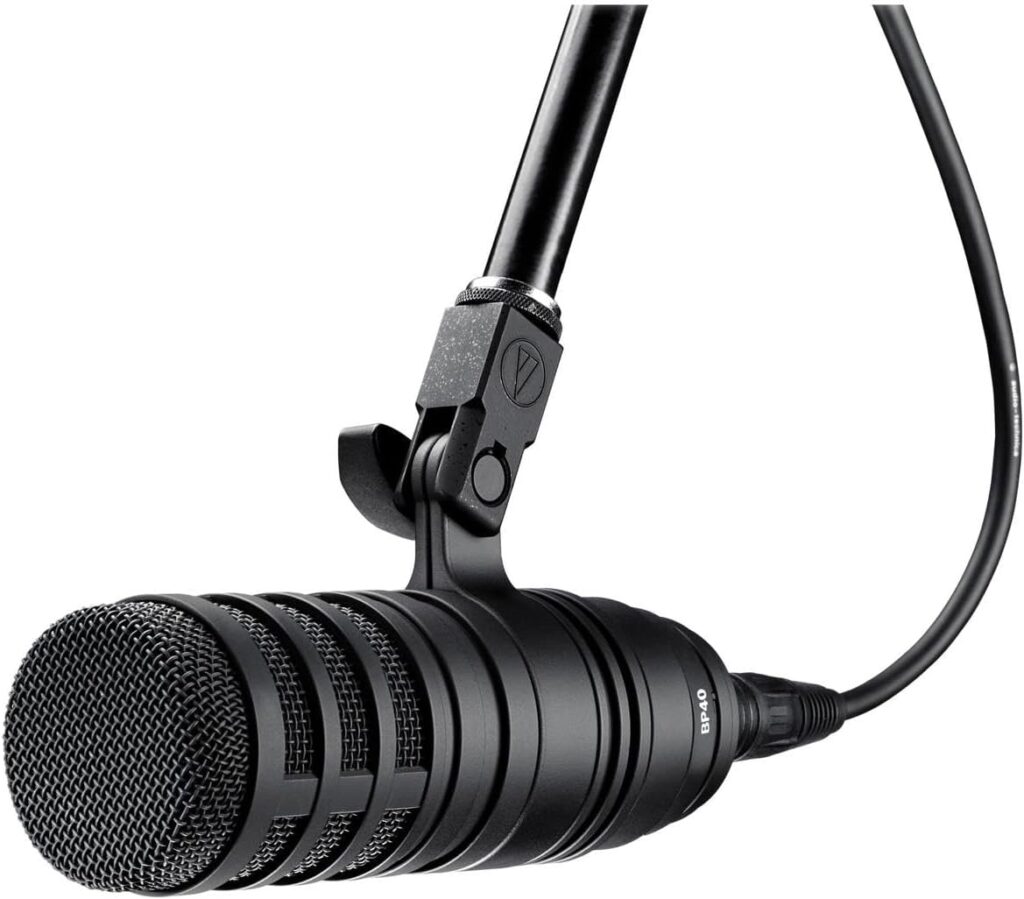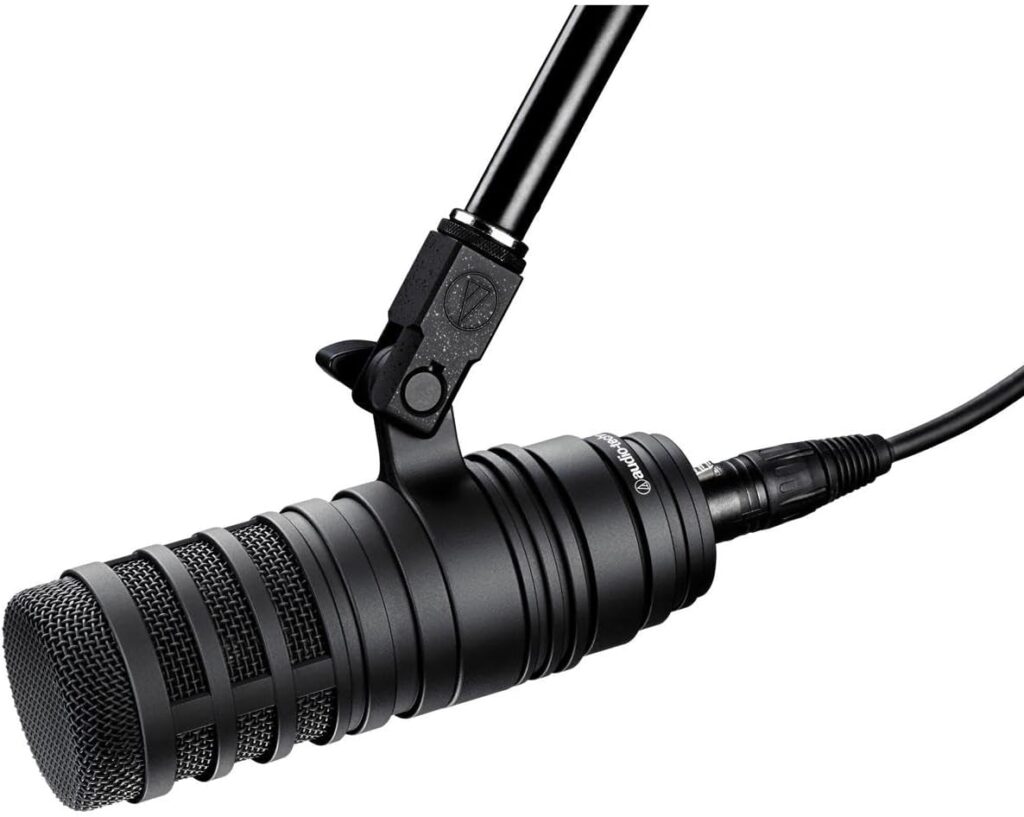Audio Technica BP40 Review
When it comes to microphones designed for broadcast, podcasting, and voiceover work, the market is filled with heavy hitters like the Shure SM7B and Electro-Voice RE20. However, Audio-Technica, a brand synonymous with quality audio solutions, entered this competitive space with the BP40—a large-diaphragm dynamic microphone aimed squarely at professionals seeking a rich, condenser-like sound with the robustness of a dynamic mic. Introduced as Audio-Technica’s first dedicated broadcast microphone, the BP40 promises to deliver exceptional vocal presence, excellent off-axis rejection, and a design that stands out both visually and functionally. In this Audio-Technica BP40 Review , we’ll explore every facet of the BP40, from its build quality to its real-world performance, to determine whether it deserves a spot in your audio toolkit.
Audio-Technica BP40 Review
The Audio-Technica BP40 immediately catches the eye with its distinctive design. At first glance, it bears a striking resemblance to the Electro-Voice RE20, with its large, cylindrical grille and robust, all-metal construction. Measuring 164mm in length and 56mm in diameter, and weighing a hefty 632g, the BP40 feels substantial in hand—a quality that inspires confidence in its durability. The body features a series of machined grooves, which Audio-Technica describes as being “inspired by the visual representation of a waveform.” While this might sound like marketing flair, the grooves serve a practical purpose: one acts as a locating indentation for the included AT8483 mounting clamp, ensuring secure placement on a stand or boom arm.
The BP40’s grille is a chunky, square-ended mesh design, reminiscent of classic broadcast mics, and it houses a 37mm large-diaphragm dynamic capsule. This capsule is mounted on an internal suspension to reduce handling noise, a thoughtful touch for a microphone intended for dynamic environments like radio studios. A multistage windscreen sits behind the grille, designed to combat plosives (those pesky “p” and “b” sounds), while a humbucking coil above the diaphragm minimizes electromagnetic interference—a common issue in studios with multiple electronic devices.
The microphone’s finish is a matte black, which not only looks sleek but also reduces glare under studio lights, making it a practical choice for on-camera use. The rear XLR connector is chrome-plated, adding a subtle touch of elegance to an otherwise utilitarian design. Overall, the BP40 exudes a sense of rugged professionalism, built to withstand the rigors of daily use while maintaining a distinctive aesthetic that sets it apart from its peers.
Technical Specifications
Before diving into sound quality, let’s break down the BP40’s key specs:
- Type: Dynamic
- Polar Pattern: Hypercardioid
- Frequency Response: 50 Hz – 16,000 Hz
- Sensitivity: -48 dB (3.9 mV) re 1V at 1 Pa
- Impedance: 450 ohms
- High-Pass Filter: Switchable 100 Hz, 6 dB/octave
- Weight: 632g
- Connector: XLR
The hypercardioid polar pattern is a standout feature, offering tighter directionality than the cardioid pattern found on mics like the Shure SM7B. This makes the BP40 particularly adept at rejecting off-axis sound, a critical attribute for isolating a single voice in a busy studio. The frequency response, spanning 50 Hz to 16 kHz, is tailored for vocal clarity, with a pronounced presence boost around 4 kHz that enhances articulation. The switchable high-pass filter at 100 Hz helps tame low-end rumble, adding versatility for different recording scenarios.
Unlike condenser microphones, the BP40 doesn’t require phantom power, making it compatible with a wide range of preamps and interfaces without additional considerations. Its sensitivity is notably higher than that of some competitors, such as the SM7B, meaning it requires less gain and reduces the need for external boosters like a Cloudlifter in many setups.
Sound Quality
The BP40’s sound profile is where it truly shines—and occasionally divides opinion. Audio-Technica markets it as delivering a “condenser-like” sound from a dynamic microphone, and in many ways, it lives up to that claim. The large diaphragm and patented floating-edge construction (which maximizes surface area and minimizes distortion) contribute to a rich, full-bodied tone that rivals the openness of some condensers while retaining the controlled proximity effect and noise rejection of a dynamic mic.
Vocal Performance
For spoken word—whether broadcasting, podcasting, or voiceovers—the BP40 excels at capturing a commanding vocal presence. The aforementioned 4 kHz presence peak gives voices a crisp, bright quality that cuts through mixes without sounding harsh. This boost is particularly flattering for voices that need extra definition, though it can be a double-edged sword: some users with naturally sibilant or high-pitched voices might find it accentuates those traits too much. In contrast, deeper voices benefit from the BP40’s healthy low-mid response around 100 Hz, which adds weight without muddiness.
Compared to the Shure SM7B, the BP40 has a more scooped frequency response, with a noticeable dip in the upper mids (around 1 kHz) and a livelier top end. The SM7B, by contrast, is flatter and more neutral, requiring EQ to achieve similar brightness. The BP40’s proximity effect is also more pronounced due to its minimal grille-to-diaphragm spacing, delivering a robust bass boost when used up close—ideal for that classic “radio voice” but potentially overwhelming without proper mic technique.
Noise Rejection
The hypercardioid pattern is a game-changer in untreated or noisy environments. With deep nulls at 120 and 240 degrees (offering at least 25 dB of rejection) and a rear tail 15 dB less sensitive than the front, the BP40 effectively minimizes room noise, bleed from other sources, and even subtle vibrations. In tests with background fans or light radio noise, the mic picks up only faint traces—impressive for a dynamic mic in its class. This makes it a strong contender for podcasters or streamers working in less-than-ideal acoustic spaces.
Versatility Beyond Voice
While designed for broadcast, the BP40’s high SPL handling (it can take loud sources without distortion) opens up other applications. On electric guitar amps, it captures a warm, detailed sound with more character than a typical Shure SM57. For drums, it shines on floor toms or even kick drums, delivering a punchy, boomy tone that complements its vocal strengths. It’s not as versatile as an SM7B or RE20 across all instruments, but it holds its own in these niche roles.
Features and Accessories
The BP40 comes with a few thoughtful features that enhance its usability. The switchable 100 Hz high-pass filter, with a gentle 6 dB/octave slope, is a welcome addition for controlling plosives and low-frequency rumble—though it’s not as aggressive as some might prefer. The internal pop filter works admirably, reducing plosive energy without muffling the sound, though users with particularly forceful delivery might still opt for an external pop shield.
Included in the box is the AT8483 mounting clamp, which fits snugly into the body’s groove and provides stable attachment to stands or booms. However, the optional AT8484 shockmount ($99) is a worthwhile investment. Its ball-bearing locking mechanism isolates the mic from stand vibrations effectively, though some users note it feels stiff and occasionally rattles. A soft protective pouch rounds out the package—adequate for storage but less critical for a mic likely to live on a boom arm.
Setup and Compatibility
Setting up the BP40 is straightforward: plug it into an XLR input, and you’re good to go. Its higher sensitivity (-48 dB) means it pairs well with budget interfaces like the Focusrite Scarlett 2i2 or mid-tier preamps like those in the Yamaha MG12XU, delivering a strong signal without excessive gain. Unlike the SM7B or RE20, which often require significant preamp boost (or a Cloudlifter), the BP40 feels “plug-and-play,” a boon for users without high-end gear.
That said, the mic’s 450-ohm impedance suggests it performs best with preamps that can handle moderate loads. In testing, it sounded clean and dynamic through a Universal Audio Apollo Twin, with no noticeable noise floor—a testament to its humbucking coil and solid engineering.
Comparisons to Competitors
Shure SM7B
The SM7B ($399) is the gold standard for broadcast mics, known for its flat response and versatility. The BP40 ($349) counters with higher sensitivity, a brighter tone, and tighter rejection, but it lacks the SM7B’s switchable EQ options and broader instrument compatibility. The SM7B’s cardioid pattern picks up more room sound, while the BP40’s hypercardioid focus is superior for isolation.
Electro-Voice RE20
The RE20 ($449) shares the BP40’s broadcast pedigree and visual vibe, with its Variable-D technology minimizing proximity effect—a feature the BP40 lacks. The RE20’s sound is smoother and less colored, while the BP40’s presence boost gives it an edge for vocal clarity. Price-wise, the BP40 undercuts the RE20, offering similar build quality at a lower cost.
Rode Podcaster
At $229, the Rode Podcaster is a budget-friendly alternative with a dynamic design and USB connectivity. The BP40 outclasses it in sound richness and build, though the Podcaster’s plug-and-play simplicity appeals to beginners. The BP40’s XLR-only design targets pros who already own interfaces.
Pros and Cons
Pros
- Rich, condenser-like sound with excellent vocal presence
- Superior off-axis rejection thanks to hypercardioid pattern
- Robust build quality and stylish design
- High sensitivity reduces need for external gain boosters
- Effective internal pop filtering and hum rejection
Cons
- Presence boost may not suit all voices
- Proximity effect requires careful mic technique
- Optional shockmount is stiff and pricey
- Less versatile than some competitors for non-vocal applications
Final Thoughts
The Audio-Technica BP40 is a triumph of targeted design. It doesn’t try to be everything to everyone—instead, it hones in on broadcast and spoken-word applications with laser focus. Its rich, articulate sound, combined with excellent noise rejection and a sturdy build, makes it a standout choice for podcasters, broadcasters, and voiceover artists. While its pronounced presence boost and proximity effect demand some finesse, these quirks are easily managed with proper technique or EQ.
For those seeking a dynamic mic that punches above its weight without breaking the bank, the BP40 is a worthy contender. It may not dethrone the SM7B or RE20 as the ultimate all-rounders, but it carves out its own niche with style and substance. If your priority is a vibrant, professional vocal sound with minimal fuss, the Audio-Technica BP40 deserves a spot on your shortlist.




